Banksy Arts
Banksy is an pseudonymous artist based in England; he primarily combines irreverent humor with graffiti, creating satirical and subversive works using a distinctive stenciling technique. Banksy’s political and social commentary have been featured on the streets, walls, and bridges of cities throughout the world. No one is sure exactly who he is: suggestions include British artists Robert Banks or Robin Gunningham but his agent refuses to either confirm or deny the reports. Simon Hattenstone from The Guardian is one of the few people to have interviewed him face to face, and describes him as “a cross of Jimmy Nail and British rapper Mike Skinner… a 28 year old male who showed up wearing jeans and a t-shirt with a silver tooth, silver chain, and one silver earring.” In the same interview, Banksy claimed that his parents think he is a painter and decorator.
Banksy himself states on his website: “I am unable to comment on who may or may not be Banksy, but anyone described as being ‘good at drawing’ doesn’t sound like Banksy to me.“
Some information is accepted: he is from Bristol, UK and got involved in graffiti art sometime in the early 90s. He began to gain widespread notoriety around 2003. He was born in or around 1974 and sports a silver tooth. He is, according to the few people who have met him, an unassuming and typical-looking man. He played football with the Easton Cowboys and Cowgirls in the 1990s and toured with the club to Mexico in 2001 -all under the pseudonym.
Banksy began as a freehand graffiti artist in 1990–1994, working with Bristol’s DryBreadZ Crew’s Kato and Tes. His work was part of the larger Bristol underground scene and he originally used stencils as elements of his freehand pieces, but by 2000 he had turned to stenciling almost exclusively after realizing how quickly he could complete a piece (he claims he changed to stenciling when he noticed a stenciled serial number under a garbage truck while he was hiding from police). There is some dispute in the street art world over the legitimacy of stencils, with many artists criticizing them as “cheating” but asked about the technique, Banksy said: “I use whatever it takes. Sometimes that just means
drawing a moustache on a girl’s face on some billboard, sometimes that
means sweating for days over an intricate drawing. Efficiency is the key.” He mentions in his book, Wall and Piece, that as he was starting
to do graffiti he was always too slow and was either caught or couldn’t finish the art in one sitting.
In August 2005 Banksy made a trip to the Palestinian territories and
created nine images on Israel’s highly controversial West Bank barrier. Reportedly soldiers do not take kindly to professional entities spending a lot
of time at one place on the wall: people are generally arrested and accused of trying to destroy
the structure. Eventually the local MP was
called out to diffuse the eighty-strong crowd that had built up (by
which time Banksy had left) and the final piece was completed by local
kids.
In late August 2008 Banksy produced a series of works in New Orleans commemorating the third anniversary of Hurricane Katrina, mostly painted on
buildings derelict since the disaster. However, “anti-street-art crusader” Fred Radtke (a.k.a. the “gray ghost”) intentionally covered most of the paintings with his own signature splotches of gray without the permission of the property owners. Banksy was well aware of Radtke, and in typical style did two of the murals taunting him. Of the six murals only “Rain Girl” remains, now covered with plexiglass: in 2009, Radtke painted over a commissioned mural and was charged with criminal trespassing.
Traditional Media / Installations
Banksy’s first Los Angeles exhibition debuted at 33⅓ Gallery on 19 June 2002. The exhibition, entitled Existencilism, was curated by 33⅓ Gallery, Malathion LA’s Chris Vargas, Funk Lazy Promotions’ Grace Jehan, and B+. At the 2003 Turf War exhibition
Banksy painted on live animals; although the RSPCA declared the conditions
suitable, an animal rights activist chained herself to the railings in
protest. He later moved on to producing subverted paintings; one example
is Monet’s Water Lily Pond, adapted to include urban detritus such as
litter and a shopping trolley floating in its reflective waters. Another
is Edward Hopper’s Nighthawks redrawn to show the characters looking at a British football hooligan. These oil paintings were shown at a twelve-day exhibition in
Westbourne Grove, London in 2005.
In August 2004 Banksy produced a quantity of spoof British £10 notes substituting the picture of the Queen with Diana, Princess of Wales and changing the text to “Banksy of England.” A limited run of 50 signed posters containing ten uncut notes were also
produced and sold by Pictures on Walls for £100 each to commemorate the
death of Princess Diana. One of these sold in October 2007 at Bonhams auction house in London for £24,000. Prices of his conventional works soon skyrocketed, although he continued to do street art; after a stunning auction of his paintings by Sotheby’s in 2007 which brought in some £372,000, Banksy updated his website with an image of people bidding on a picture that said “I Can’t Believe You
Morons Actually Buy This Shit.” He also claims he “…is not represented by any of the commercial galleries that
sell [his] work second hand (including Lazarides Ltd, Andipa Gallery, Bank
Robber, Dreweatts etc),”
Lost Works
There have been stories of unscrupulous dealers stripping his work off the streets and and even attempting to sell his street art on location -leaving the problem of its removal in the hands of the winning bidder. Banksy himself is well known for his contempt for the government in labeling graffiti as vandalism.
Critics have included Peter Gibson, a spokesman for Keep Britain Tidy who asserts that Banksy’s work is simple vandalism; Diane Shakespeare, an official for the same organisation was quoted as saying: “We are concerned that Banksy’s street art glorifies what is essentially vandalism.” In his column for The Guardian, satirist Charlie Brooker wrote of Banksy “…his work looks dazzlingly clever to idiots.”
 In April 2007 Banksy’s famous piece depicting Pulp Fiction characters pointing bananas instead of guns was painted over by London Transport workmen
In April 2007 Banksy’s famous piece depicting Pulp Fiction characters pointing bananas instead of guns was painted over by London Transport workmen
despite having an estimated value of more than £300,000 at the time.
Asked to comment on the mural’s destruction, a Transport for London
spokesman said “Our graffiti removal teams are staffed by professional cleaners not professional art critics.” That same year a mural of a policeman stopping and searching a young girl in Glastonbury was whitewashed over.
In 2009 two works were jet washed in Dalston, London, and a third work of a boy holding a stereo and a teddy bear became the subject of legal action opposing its ablation. In March 2010 prints of “Forgive us our Trespassing” (promoting Exit Through The Gift Shop) were displayed in
the London underground, but censored to remove the halo
over the boy’s head. After a few days the halo was repainted by an anonymous artist; the work was then deemed to be “defaced” and removed by Tube advertising bosses.
In 2010 a Detroit piece showing a little boy holding a can of red paint next
to the words “I remember when all this was trees” was excavated by the
555 Nonprofit Gallery and Studios; they claim that they do not intend to
sell the work but plan to preserve it and display it at their Detroit
gallery. In 2011 a Mickey Mouse-inspired “Livin’ the Dream” (painted over a billboard ad) was removed and destroyed in Los Angeles, and another piece entitled “Caution” was cut out of a wall and stolen.
On 6 July 2010, “Gorilla with Pink Face Mask” in Bristol was painted over when the building was turned into a Muslim cultural center; the new
owners of the building were ignorant of its significance and simply assumed it was a regular piece of graffiti, but they are reportedly looking into restoration (in their defense it had been dogged heavily and was barely recognizable). In May 2012 his Parachuting Rat, painted in Melbourne in the late 1990s, was accidentally destroyed by plumbers installing new pipes. In addition numerous pieces have been dogged
by other graffiti artists, taggers or simple vandals.
The removal of Banksy’s work has of course stirred controversy across a spectrum of artists, city councils, property owners and preservationists. On the side of preservation there is disagreement on whether the pieces should be protected by fencing or perspex sheets; many street artists maintain that graffiti is ephemeral (and illegal) by nature and turning it into a legitimate display defeats its character. Property owners are often either ignorant of a work’s significance or faced with the dilemma of overlaying vandalism. And of course the municipalities generally just want to follow the book and remove anything that isn’t authorized by code.
The Banksy / Robbo Graffiti War
In 1985 “King Robbo” painted a large graffiti piece called Robbo
Incorporated on a wall beside Regent’s Canal in Camden, London. In
2009 Banksy covered most of it with a stencil of a workman pasting
wallpaper. This incident led to some online outrage and a graffiti war with
many of Banksy’s other works being altered by “Team Robbo”.
On April 2, 2011 King Robbo sustained a
life threatening head injury as a result of an accidental fall, which
placed him in an induced coma. In November of that year Bansky painted
a tribute to him as an effort to end the feud. The mural was restored
by the other members of the “Team Robbo” but the restoration has since
peeled away to leave the black and white tribute.
Exit Through the Gift Shop
In 2010 Banksy’s first film, Exit Through the Gift Shop made its debut at the 2010 Sundance Film Festival billed as “the world’s first street art disaster movie”. In January 2011 he was nominated for the Academy Award for Best Documentary. Banksy released a statement saying “This
is a big surprise… I don’t agree with the concept of award ceremonies,
but I’m prepared to make an exception for the ones I’m nominated for.
The last time there was a naked man covered in gold paint in my house,
it was me.” Leading up to the Oscars, Banksy blanketed Los Angeles with street art.
Banksy’s work is applauded by many, but some critics say that it oversimplifies issues to appeal to the masses. Other critics believe that Banksy’s street art is a crime and that he is setting a negative example for other would-be graffiti artists.
Personally, I simply wish he’d notice my garage doors.
References:
Banksy – Official Site
The Robbo / Banksy War
http://1nsp1red.blogspot.com/2010/04/banksy.html

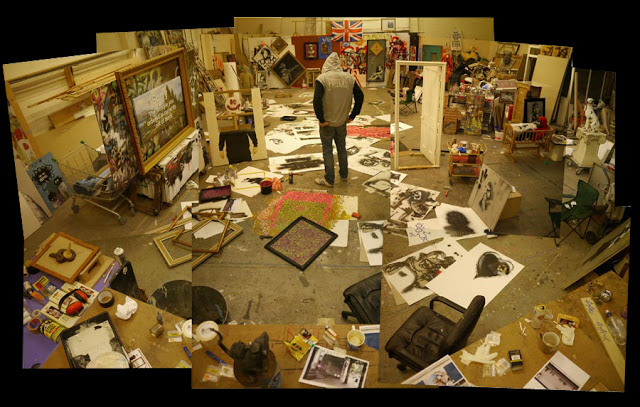







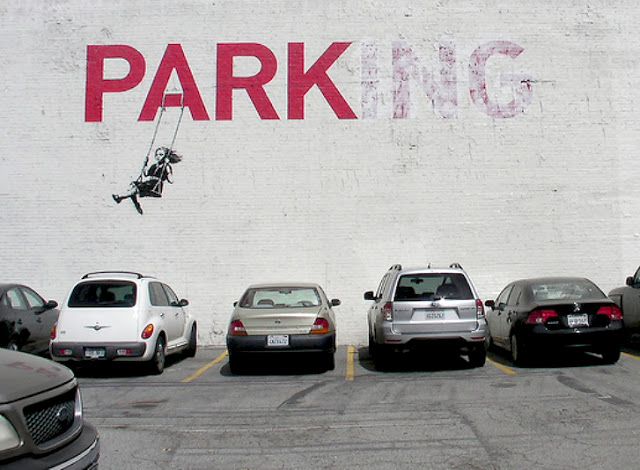














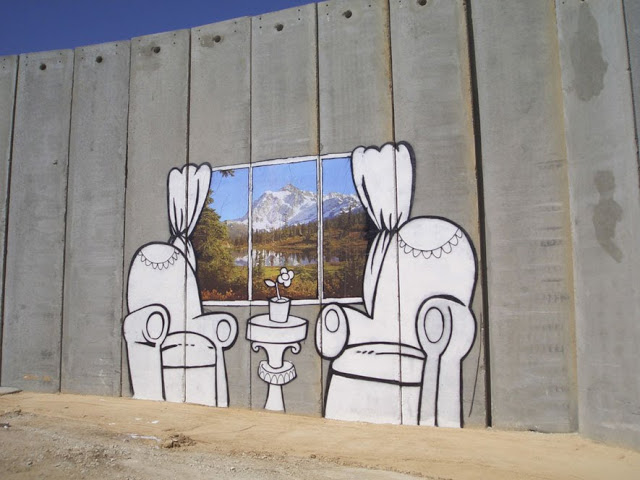
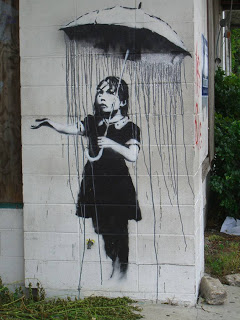
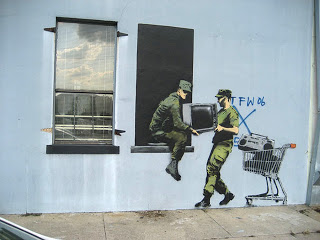








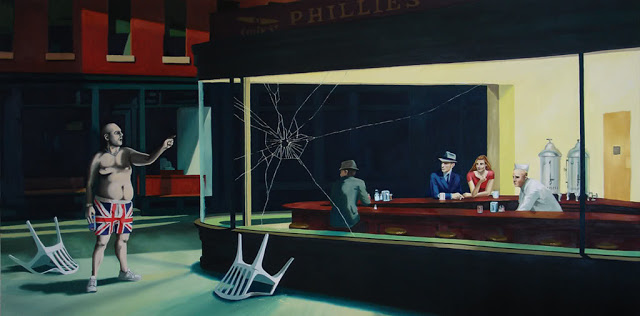




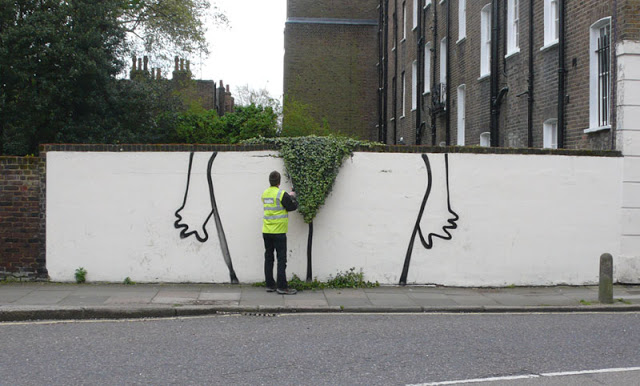









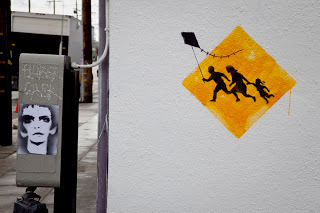


















Comments
Banksy Arts — No Comments
HTML tags allowed in your comment: <a href="" title=""> <abbr title=""> <acronym title=""> <b> <blockquote cite=""> <cite> <code> <del datetime=""> <em> <i> <q cite=""> <s> <strike> <strong>